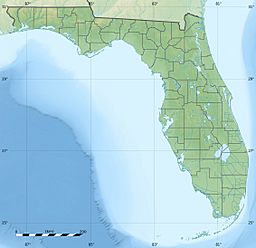Lochloosa Lake facts for kids
Quick facts for kids Lochloosa Lake |
|
|---|---|

Lochloosa Lake
|
|
| Location | Alachua County, Florida |
| Coordinates | 29°31′00.296″N 82°07′14.19″W / 29.51674889°N 82.1206083°W |
| Type | lake |
| Primary outflows | Cross Creek |
| Surface area | 6,100 acres (2,500 ha) |
| Max. depth | 10 feet (3.0 m) |
Lochloosa Lake is a beautiful lake located in Alachua County, Florida. It's about 4 miles south of a town called Hawthorne. This lake is quite large, covering an area of about 6,100 acres. It's also fairly shallow, usually no deeper than 10 feet.
Lochloosa Lake is a very important natural area. It is mostly surrounded by the Lochloosa Wildlife Management Area. This means the land around the lake is protected for animals and plants. The lake itself is also a Fish Management Area, which helps keep the fish healthy.
Contents
What Makes Lochloosa Lake Special?
Lochloosa Lake is well-known for its excellent fishing. Many people come here to catch fish, especially bass. It's a popular spot for anglers of all ages.
Water Flow and Connections
Lochloosa Lake is part of a larger water system. Its biggest natural water source, or tributary, is Lochloosa Creek. Water flows out of Lochloosa Lake through a stream called Cross Creek. This creek then carries the water into another nearby body of water, Orange Lake.
Challenges and Changes in the Lake
Lakes can change over time, and Lochloosa Lake has faced some challenges.
Dealing with Droughts
Around 2012, the area experienced a drought. A drought is a long period with very little rain. This caused the water levels in Lochloosa Lake to drop. As of 2017, the lake had not fully returned to its normal water levels.
Plants in the Lake
Sometimes, certain plants can grow too much in a lake. In Lochloosa Lake, a plant called hydrilla has become a problem. When there's too much hydrilla, it can make it hard for boats to move. It can also affect the fish and other wildlife.
Natural Water Level Changes
The water level in Lochloosa Lake can change a lot, sometimes by as much as 10 feet. This might sound like a big change, but it's actually natural and healthy for the lake's ecosystem. These changes help different plants and animals thrive. The Orange Creek Basin Advisory Council, a group that helps manage the water, decided not to try and force the lake's water level to stay the same. They understood that natural changes are good for the lake's health.



